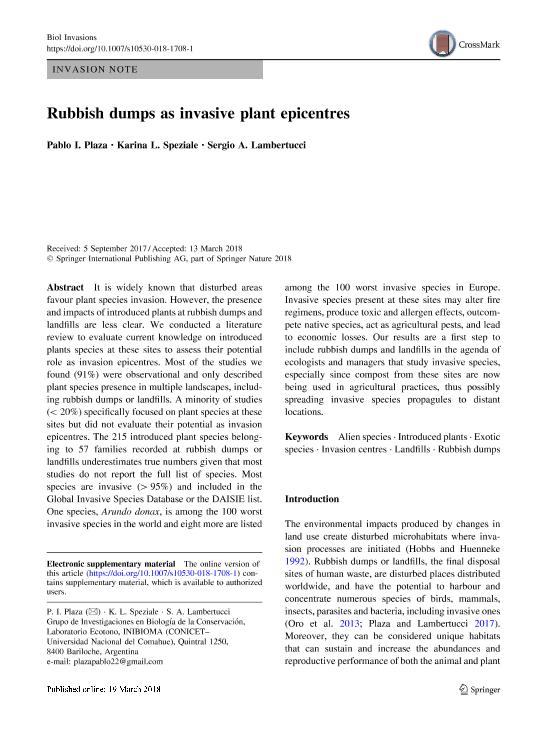Mostrar el registro sencillo del ítem
dc.contributor.author
Plaza, Pablo

dc.contributor.author
Speziale, Karina Lilian

dc.contributor.author
Lambertucci, Sergio Agustin

dc.date.available
2020-01-14T21:14:26Z
dc.date.issued
2018-09
dc.identifier.citation
Plaza, Pablo; Speziale, Karina Lilian; Lambertucci, Sergio Agustin; Rubbish dumps as invasive plant epicentres; Springer; Biological Invasions; 20; 9; 9-2018; 2277-2283
dc.identifier.issn
1387-3547
dc.identifier.uri
http://hdl.handle.net/11336/94720
dc.description.abstract
It is widely known that disturbed areas favour plant species invasion. However, the presence and impacts of introduced plants at rubbish dumps and landfills are less clear. We conducted a literature review to evaluate current knowledge on introduced plants species at these sites to assess their potential role as invasion epicentres. Most of the studies we found (91%) were observational and only described plant species presence in multiple landscapes, including rubbish dumps or landfills. A minority of studies (< 20%) specifically focused on plant species at these sites but did not evaluate their potential as invasion epicentres. The 215 introduced plant species belonging to 57 families recorded at rubbish dumps or landfills underestimates true numbers given that most studies do not report the full list of species. Most species are invasive (> 95%) and included in the Global Invasive Species Database or the DAISIE list. One species, Arundo donax, is among the 100 worst invasive species in the world and eight more are listed among the 100 worst invasive species in Europe. Invasive species present at these sites may alter fire regimens, produce toxic and allergen effects, outcompete native species, act as agricultural pests, and lead to economic losses. Our results are a first step to include rubbish dumps and landfills in the agenda of ecologists and managers that study invasive species, especially since compost from these sites are now being used in agricultural practices, thus possibly spreading invasive species propagules to distant locations.
dc.format
application/pdf
dc.language.iso
eng
dc.publisher
Springer

dc.rights
info:eu-repo/semantics/openAccess
dc.rights.uri
https://creativecommons.org/licenses/by-nc-sa/2.5/ar/
dc.subject
ALIEN SPECIES
dc.subject
EXOTIC SPECIES
dc.subject
INTRODUCED PLANTS
dc.subject
INVASION CENTRES
dc.subject
LANDFILLS
dc.subject
RUBBISH DUMPS
dc.subject.classification
Conservación de la Biodiversidad

dc.subject.classification
Ciencias Biológicas

dc.subject.classification
CIENCIAS NATURALES Y EXACTAS

dc.title
Rubbish dumps as invasive plant epicentres
dc.type
info:eu-repo/semantics/article
dc.type
info:ar-repo/semantics/artículo
dc.type
info:eu-repo/semantics/publishedVersion
dc.date.updated
2019-10-10T13:46:58Z
dc.journal.volume
20
dc.journal.number
9
dc.journal.pagination
2277-2283
dc.journal.pais
Alemania

dc.journal.ciudad
Berlín
dc.description.fil
Fil: Plaza, Pablo. Universidad Nacional del Comahue. Centro Regional Universitario Bariloche. Laboratorio de Ecotono; Argentina. Consejo Nacional de Investigaciones Científicas y Técnicas. Centro Científico Tecnológico Conicet - Patagonia Norte. Instituto de Investigaciones en Biodiversidad y Medioambiente. Universidad Nacional del Comahue. Centro Regional Universidad Bariloche. Instituto de Investigaciones en Biodiversidad y Medioambiente; Argentina
dc.description.fil
Fil: Speziale, Karina Lilian. Consejo Nacional de Investigaciones Científicas y Técnicas. Centro Científico Tecnológico Conicet - Patagonia Norte. Instituto de Investigaciones en Biodiversidad y Medioambiente. Universidad Nacional del Comahue. Centro Regional Universidad Bariloche. Instituto de Investigaciones en Biodiversidad y Medioambiente; Argentina. Universidad Nacional del Comahue. Centro Regional Universitario Bariloche. Laboratorio de Ecotono; Argentina
dc.description.fil
Fil: Lambertucci, Sergio Agustin. Consejo Nacional de Investigaciones Científicas y Técnicas. Centro Científico Tecnológico Conicet - Patagonia Norte. Instituto de Investigaciones en Biodiversidad y Medioambiente. Universidad Nacional del Comahue. Centro Regional Universidad Bariloche. Instituto de Investigaciones en Biodiversidad y Medioambiente; Argentina. Universidad Nacional del Comahue. Centro Regional Universitario Bariloche. Laboratorio de Ecotono; Argentina
dc.journal.title
Biological Invasions

dc.relation.alternativeid
info:eu-repo/semantics/altIdentifier/url/http://link.springer.com/10.1007/s10530-018-1708-1
dc.relation.alternativeid
info:eu-repo/semantics/altIdentifier/doi/http://dx.doi.org/10.1007/s10530-018-1708-1
Archivos asociados
